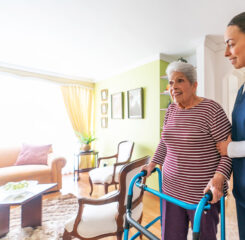In an increasingly connected world, those working in senior living communities and community-based organizations understand that older adults are now asked to navigate technology as a part of daily life—to communicate with family and staff, access health information, and even participate in community events. The question often arises: Should our organization rely on purpose-built technology designed specifically for older adults, or focus on helping them use the same mainstream tools everyone else does?
The truth is, the device matters less than the confidence and competence to use it. Digital literacy—knowing how to navigate a touchscreen, recognize icons, manage passwords, and troubleshoot basic problems—is the foundation for all successful technology use and adoption. It’s what allows an older adult to pick up a smartphone or tablet and use it with curiosity instead of fear. It’s what enables someone to join a virtual family gathering, schedule a telehealth appointment, or simply find joy in watching a favorite show online.
While purpose-built technologies have made enormous strides in improving accessibility, simplicity, and safety for older adults, they can also create unintended barriers. Devices like GrandPad, and other simplified video chat tablets/TV set top box or wearables, are designed to reduce complexity. Yet when residents are only introduced to these specialized platforms that don’t resemble the tools used by the broader population, they may learn to use a custom device but still feel lost when handed a standard smartphone. They may start to believe these “real” devices aren’t meant for them at all, and they may miss out on using technologies that could support their cognition and increase their quality of life.
Broad Technology Use Can Empower Older Adults
Research published last spring in Nature Human Behavior—a review of 136 studies with data that encompassed over 400,000 adults, and longitudinal studies with an average of 6 years of follow-up data—found that using digital technologies can promote behaviors that preserve cognition, yielding a 58% lower risk of cognitive impairment.
Offering older adults a manageable challenge can be healthy. In addition to learning the skills needed to use devices, technology requires constant adaption, such as understanding new software updates, troubleshooting Internet loss, or filtering out website ads, said study co-author Michael K. Scullin, Ph.D., associate professor of psychology and neuroscience at Baylor University. Overcoming these difficulties is “actually a reflection of the cognitive challenge, which may be beneficial for the brain even if it doesn’t feel great in the moment,” he said.
Access to a wide range of technologies can also help to preserve independence. Tools such as digital reminders, GPS navigation, and online banking allow older adults to remain independent despite cognitive difficulties. Together, these tools form a digital scaffold that “facilitates better functional outcomes in older adults while general cognitive functioning declines,” according to the research article.
While many purpose-built technologies can support older adults’ needs, comfort with digital mainstream technologies empowers older adults to connect well with family members’ devices; tap apps for medication management, telehealth appointments, and hobbies; or exercise cognitive function and creativity by making videos.
That’s why efforts to build digital skills—patiently, consistently, and in community—are so vital. They help shift the mindset from “this is too complicated for me” to “I can figure this out.” With digital confidence, older adults can adapt more easily as technologies evolve. They’re more resilient when systems change, and more empowered to seek out tools that match their own interests, needs, and communication styles.
Purpose-built Tools Are Key to Supporting Populations with Special Needs
That said, purpose-built tools still serve an important role, especially in specific care settings or for individuals with specific accessibility needs. For example, residents living with cognitive decline may benefit from simplified interfaces that reduce cognitive load, while those with vision, hearing, or dexterity challenges may need larger icons, voice controls, closed captioning, or tactile feedback that consumer devices don’t always offer. In these situations, purpose-built technology provides a critical layer of support—but it should be seen as part of a larger ecosystem, not the whole solution.
Digital Literacy Offers Older Adults Choice
At the end of the day, the most powerful technology strategy is the one that equips older adults with the ability to choose. When we prioritize digital literacy, we’re not just teaching people how to use a device; we’re expanding their agency, their connection to others, and their ability to thrive in a digital world. Whether through a mass-market app or a carefully designed senior tech platform, the goal is the same: helping people feel confident, capable, and connected.
Looking for examples of how senior living providers are helping residents build confidence with technology and training? Check out these case studies from LeadingAge CAST.

 Shutdown Week Three: Impact of Ongoing Closure on Affordable Housing
Shutdown Week Three: Impact of Ongoing Closure on Affordable Housing Colleagues on the Move, January 7, 2026
Colleagues on the Move, January 7, 2026 RHT Program Awards: All 50 States To Receive Funds, Says CMS
RHT Program Awards: All 50 States To Receive Funds, Says CMS


